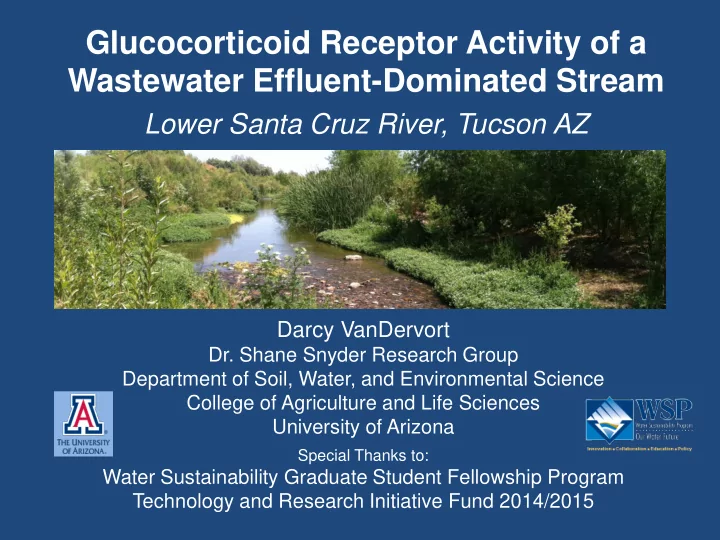

Glucocorticoid Receptor Activity of a Wastewater Effluent-Dominated Stream Lower Santa Cruz River, Tucson AZ Darcy VanDervort Dr. Shane Snyder Research Group Department of Soil, Water, and Environmental Science College of Agriculture and Life Sciences University of Arizona Special Thanks to: Water Sustainability Graduate Student Fellowship Program Technology and Research Initiative Fund 2014/2015
Wastewater Treatment Plant Discharge 85% of municipal wastewater treatment plants discharge into surface waters in the United States
Glucocorticoid Hormones • Human secreted and synthetic • Anti-inflammatory properties that treat health problems such as asthma and rheumatic diseases • Not filtered out by typical wastewater treatment systems • Detected in the environment around the world including US, Netherlands, and China • Disrupt biological endocrine systems
Santa Cruz River Sampling Sites
Glucocorticoid Receptor Bioassay • Expose genetically modified cells to river extracts • Agonists bind to glucocorticoid receptors • Quantify by fluorescence
Glucocorticoid Chemical Analysis Solid Phase Extraction 28 Target Analytes Aldosterone Flumethasone Amcinonide Flunisolide Beclomethasone Fluocinolone Acetonide Beclomethasone Dipropionate Fluocinonide Betamethasone Fluorometholone Budesonide Fluticasone Propionate Clobetasol Propionate Hydrocortisone 6- α -Methylprednisolone Clobetasone Butyrate Corticosterone Mometasone Furoate Liquid Chromatography Cortisone Prednisolone Deflazacort Prednisone Tandem Mass Spectrometry Deoxycorticosterone Acetate Spironolactone Dexamethasone Triamcinolone Fludrocortisone Acetate Triamcinolone Acetonide 8 Surrogates Cortisone-d8 Fludrocortisone-d5 Cortisone-d8 Methylprednisolone-d2 Hydrocortisone-d4 Prednisolone-d6 Dexamethasone-d4 Prednisone-d4
Dexamethasone Dose Response 100 Plate1 80 Effective Use Plate2 Percent 60 Plate3 40 Plate4 Plate5 20 Plate6 0 1.E-11 1.E-10 1.E-09 1.E-08 1.E-07 Plate7 -20 Concentration (M)
GR Activity of the SCR AN TR 200 12-May-14 150 DEX-EQ (ng/L) 6-Jun-14 100 22-Sep-14 50 1-Dec-14 12-Feb-15 0 0.0 10.0 20.0 30.0 Stream Distance (km) -50
Chemical Glucocorticoid Concentrations (ng/L) Distance Prednsl. Beta. Triam. Fluoc. Sample Cort. Hydrocort. (km) Acet. Acet. 12/1/2014 SCR1 0.0 0.52 2.08 0.75 0.47 37.03 1.30 SCR2 1.3 0.39 1.62 0.64 0.54 33.25 1.43 SCR4 7.6 0.21 0.59 0.84 0.22 37.66 1.63 SCR5 9.7 0.19 0.65 0.86 0.26 34.62 1.50 SCR6 13.0 0.16 0.63 0.65 0.35 26.64 1.21 SCR8 17.0 0.27 0.66 0.85 0.43 29.51 1.24 SCR9 24.0 0.11 0.38 0.65 0.33 15.46 0.78 SCR10 28.8 0.11 0.34 0.54 0.24 7.29 0.57 2/12/2015 SCR1 0.0 0.69 1.94 0.97 0.29 28.91 1.42 SCR2 1.3 0.43 1.74 0.59 0.42 22.52 1.00 SCR3 6.4 0.42 1.38 0.48 0.29 8.64 0.53 SCR4 7.6 0.27 0.73 1.06 0.16 31.22 1.22 SCR5 9.7 0.25 0.84 0.94 0.20 26.93 1.09 SCR6 13.0 0.20 0.73 0.84 0.22 18.51 0.93 SCR8 17.0 < 0.04 0.74 0.84 0.30 19.94 0.89
Chemical vs Bioassay Data TR AN 200 February 175 Chemical Dex-Eq (ng/L) 150 February 125 Bioassay 100 December 75 Chemical 50 December 25 Bioassay 0 0.0 10.0 20.0 30.0 Stream Distance (km)
Conclusions • Decrease in Glucocorticoid concentrations downstream from treatment plants – Photolysis – Biodegradation – Deposition/Sediment sorption • Chemical data can’t predict GR response – Unknown compounds causing response – Synergy effects of mixtures
Acknowledgements • Shane Snyder Lab Bioassay Team: Ai Jia, Kevin Daniels, Hao Vo • Shimin Wu • Fred Leusch, Griffith University School of Environment • Jeff Bliznick, University of Arizona Soil Water and Environmental Science • Matt Kaplan and the University of Arizona Functional Genomics Core Lab Team • Kelly Reynolds and Jonathan Sexton, University of Arizona School of Public Health • Thesis Committee: Shane Snyder, David Quanrud, and Jon Chorover • Agilent Technologies
References Ammann, A.A., Macikova, P., Groh, K.J., Schirmer, K., Suter, M.J.F., 2014. LC- MS/MS determination of potential endocrine disruptors of cortico signalling in rivers and wastewaters. Anal. Bioanal. Chem. 406, 7653–65. Chang, H., Hu, J., Shao, B., 2007. Occurrence of natural and synthetic glucocorticoids in sewage treatment plants and receiving river waters. Environ. Sci. Technol. 41, 3462–3468. Escher et al., Benchmarking organic micropollutants in wastewater, recycled water and drinking water with in vitro bioassays. Environ. Sci. Technol. 48, 1940– 1956. Stavreva, D. a, George, A. a, Klausmeyer, P., Varticovski, L., Sack, D., Voss, T.C., Schiltz, R.L., Blazer, V.S., Iwanowicz, L.R., Hager, G.L., 2012. Prevalent glucocorticoid and androgen activity in US water sources. Sci. Rep. 2, 937. USEPA, 2008. Clean Watersheds Needs Survey (CWNS) 2008: Report to Congress. Washington, DC. EPA-832-R-10-002 Van der Linden, S.C., Heringa, M.B., Man, H.-Y., Sonneveld, E., Puijker, L.M., Brouwer, A., van der Burg, B., 2008. Detection of Multiple Hormonal Activities in Wastewater Effluents and Surface Water, Using a Panel of Steroid Receptor CALUX Bioassays. Environ. Sci. Technol. 42, 5814–5820.
Recommend
More recommend